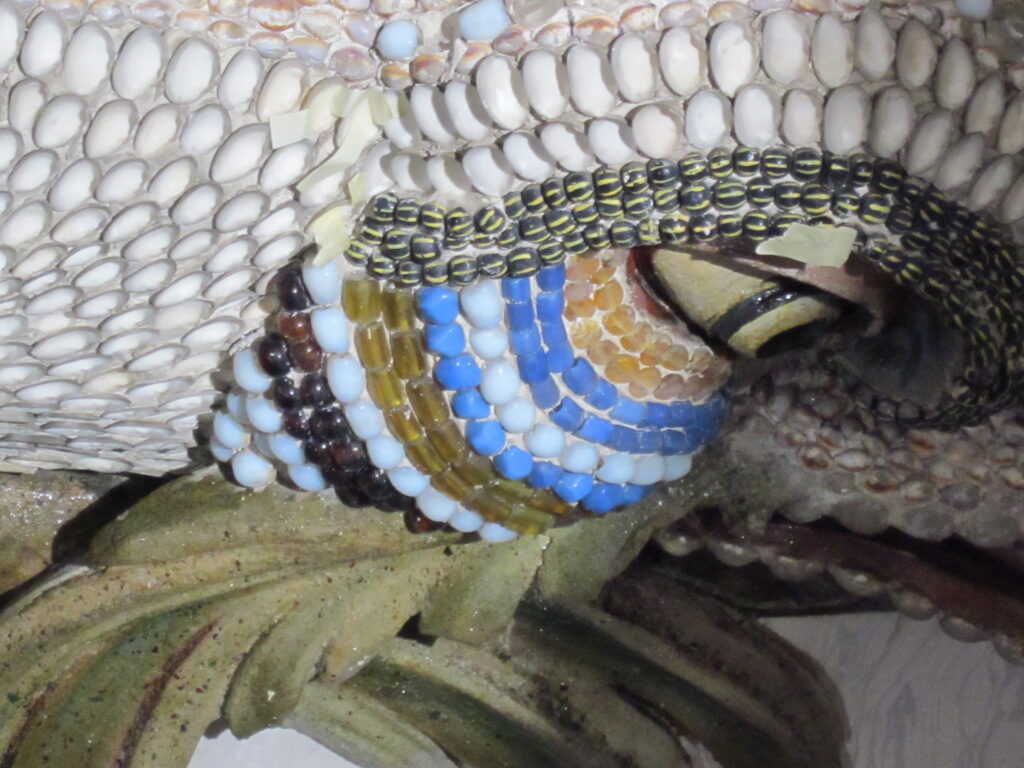
Glass Grottowork in the Dutch Garden

Shortly after construction on the Picture Gallery began to the east of Sanssouci Palace, Frederick II, incognito, undertook a trip to Holland in 1755, where he looked at collections of paintings. The king also seems to have been interested in Dutch Gardens and grotto art because he was planning the garden area between the Oranierrondell (House of Orange Rondel) and the Picture Gallery. In Tulpenburg, Frederick made the acquaintance of the gardener and grotto designer Joachim Ludwig Heydert, whom he appointed to Potsdam to realise the Dutch Garden and the grottowork on the upper terrace wall adjacent to the Picture Gallery.
The grottoworks Heydert carried out in Potsdam have not survived. However, a general idea of these decorations is conveyed through a drawing by Johann David Schleuen from 1770, a sketch by Adolph Menzel from 1842, and contemporaneous descriptions. According to these sources, the glass ornamentation was inserted in a highly distinctive form in both the Dutch Garden and the grottowork wall: “Each section of the artificial grotto, the base of which is covered with mother-of-pearl shells or cristal de roche [rock crystal], with mascarons [ornamental, chimeric faces] and festoons [garlands; swags], whose flower faces, fruit and feathered bushes are composed of genuine coral, shells and glass coral.” (Salzmann, 1772).

The parterre in front of the terrace wall consisted of two-quarter circles with Boxwood contours filled in with blue glass coral, which had been threaded onto long strings and laid out on the gravel. An eyewitness of the time described the area as follows: “A Dutch Garden partition with an open berceau [arched walkway], adjacent to two parterres, whose foliage is adorned with glass coral.” (Salzmann, 1772). Garden designer Heydert’s grandson wrote: “Heydert laid out the parterres there … in the Dutch style; using Boxwood to shape the contours, between which he laid out strings of coral, which made a nice impression when seen from the roof of the Picture Gallery.” He also noted that all of the coral was blue. The glass ornamentation decisively contributed to the effect since this garden section was called the “Korallengarten” (Coral Garden). The wall and parterres were clearly intended as an artistic ensemble.
Since the grotto wall along the Picture Gallery met with the approval of Frederick II, he also initially commissioned Joachim Ludwig Heydert to create a grotto for the “sala terrena” on the ground floor of the New Palace, the so-called Grotto Hall. However, the king found his cost estimate too high, so shortly after, in 1767, Johann Melchior Kambly and Matthias Müller received the commission instead. They wanted to use less precious materials for the design and complete many of the walls in plaster. For a total sum of 2856 thalers, Heydert sold them shells, snails, coral and other materials used for grottowork that had been left over from the construction of the terrace wall.
By the mid-19th century, the grotto wall along the Picture Gallery was in very poor condition due to outdoor weathering effects. And because of the popularity of taking shells and glass pieces as souvenirs, the patterns were barely recognisable. The glass beads in the parterres in front of the grotto wall were also severely depleted. Frederick William IV had this section of the garden repaired and renewed by Ludwig Ferdinand Hesse in 1847‒50. The grotto wall received a new sectional layout based on Hesse’s design; the glass beads and coral came from the Gräflich Schaffgotsch’sche Josephinenhütte [Kunstglasfabrik = artificial glass factory] in Schreiberhau near Warmbrunn in Silesia. But as early as 1896, this garden section underwent another complete renewal, at which time the “Coral Garden” was sacrificed.
During archaeological research excavations of the garden in 2014, a large number of beads made from coloured glass and glass shards were found in this area, in addition to ceramics, iron, brick and other fragments. Some of the excavation findings likely belong to the early period of the Dutch Garden. The parterre’s later glass beads were consistently described as blue, although white, red, green, brown, amber-coloured, dark, and light-coloured beads were also excavated. Moreover, finds included glass shards and pieces of iron, shell fragments, malachite fragments, sedimentation, lava and slate fragments – all these materials seem much more likely to have originated from the grotto wall rather than the parterre. A coin from 1779 was also among the finds, making it possible that the abundant glass finds could, in part, be dated back to Heydert’s first design phase of the wall and the parterres. This is supported by a comparison with the glass beads from the Grotto Hall, which date from the 1760s. The white and blue beads, in particular, are almost identical in their outward appearance and chemical composition. They may have come from a smelting foundry. Perhaps these were the remaining materials of the grotto wall decoration, which Heydert sold to Kambly and Müller for the Grotto Hall in 1767. In this case, the rest of Heydert’s glass grotto materials were also preserved in the Grotto Hall at the New Palace.
– Dr. Susanne Evers, Sammlungskustodin, Stiftung Preußische Schlösser und Gärten
Header Image: Johann David Schleuen: Prospect der Bilder-Gallerie im Königlichen Garten Sans-Soucy bei Potsdam (View of the Picture Gallery in the Sanssouci Royal Garden near Potsdam), 1770 │ Photo: SPSG






